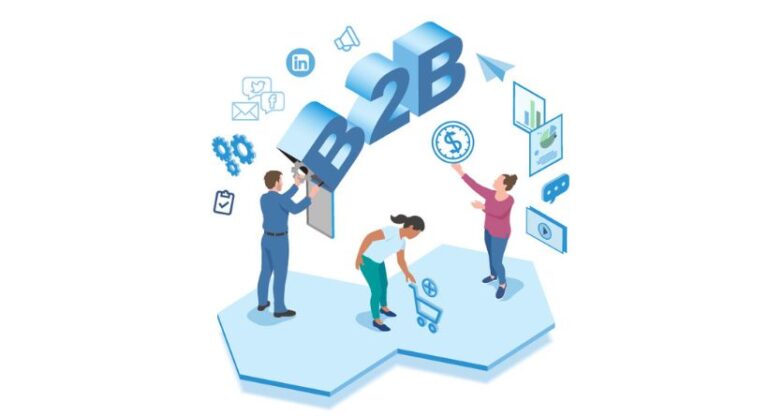The products and services that consumers and business owners take for granted wouldn’t exist without B2B enterprises and the supply chain.
- B2B enterprises produce goods and services for other companies, organizations, and nonprofits.
- B2B companies have particular difficulties, such as managing cash flow, and are required to constantly innovate and win over new clients.
- B2B enterprises should think about optimizing their websites and experimenting with lead-generation services that assist them in reaching decision-makers if they want to increase earnings and increase market share.
- The goal of this essay is to help current and prospective company owners better understand the B2B business model.
“Business to business” is referred to as B2B. It’s a business strategy where the participating firms produce goods and services for other companies and organizations. Software as a service (SaaS), marketing agencies, and organizations that produce and market different commodities are examples of B2B corporations.
No of the size of your company, you will eventually need to buy goods or services from B2B businesses. We will discuss the B2B business model and ways that B2B companies may increase their revenue and market share.
Describe B2B.
The business-to-business concept involves the trade of products and services between companies. For instance, a firm could enter into a contract with another company to provide the raw ingredients required to make a product.
While some businesses employ businesses to market their goods and services, ensure their operations, create their logos, or create website content, other businesses may need to buy things from other businesses to fill their shelves.
Although they don’t play a direct role in business-to-business transactions, consumers have a significant role in why B2B organizations collaborate.
There are other business models used in the supply chain than B2B. Firms that sell directly to customers are known as B2C (business-to-consumer) or DTC (direct-to-consumer) businesses. B2B businesses provide goods and services to other private businesses, government agencies, and nonprofits.
Where in the supply chain do B2B businesses reside?
The primary, secondary, and tertiary economic sectors must be considered if you want to comprehend how B2B enterprises fit into the supply chain.
- Main Market: Only B2B transactions occur in the primary market. Farmers or oil and gas corporations are examples of primary-sector businesses that extract or produce basic resources.
- Secondary market: B2B transactions dominate the secondary market. Companies in the secondary market produce and put together goods. By transforming the main market raw commodities, they purchase into something different, they add value to those resources. Consider the companies that convert oil into polymers or the diamond cutters and polishers. Construction firms and automakers are examples of secondary-market assembly businesses. The B2C model is sometimes used by secondary-market businesses, such as farmers with market stalls.
- Tertiary market: The secondary market combines B2B and B2C business concepts. Some tertiary market enterprises provide the products or services that customers or businesses seek. Plumbers, online merchants, floor installers, grocers, commercial finance brokers, experts in home remodeling, teachers, and the hotel industry are just a few of these companies.
Which B2B tertiary market examples come to mind?
Some tertiary businesses exclusively deal with other businesses. They provide the products and services that other tertiary enterprises that deal with customers require to function. Here are a few instances:
- Plumbers may purchase the tools they need from plumbing supply shops.
- Retailers purchase POS systems from point-of-sale (POS) suppliers.
- To finance small company loans, equipment leasing deals, and asset-based loans, commercial finance brokers require lenders.
- Business and management consultants aid in the survival and expansion of businesses.
- For the purpose of processing consumer payments, retailers need credit card processors.
- For businesses to increase sales, they require advertising agencies.
- To manage payroll and simplify taxes, businesses require financial services providers.
- To generate money, businesses need lead generating services.
- Companies require insurance companies to safeguard their own interests as well as that of their workers and clients.
Challenges of operating a B2B business
Finding businesses to purchase their products and services is perhaps the biggest hurdle most B2B organizations encounter. Comparatively speaking, B2B markets are substantially more compact. A B2C clothes e-commerce website, for instance, would have a large audience of prospective customers.
However, corporations can have considerably larger budgets than individuals and spend more on purchases. Therefore, even if a B2B firm may generate less sales than a B2C company, it is likely to generate a far bigger profit.
Here are a few particular difficulties that B2B companies encounter.
1. To preserve consumer loyalty, B2B companies must constantly innovate.
For many B2B businesses, particularly those that provide monthly subscription-based goods and services like SaaS packages and online accounting software, innovation is a crucial concern.
B2B companies need to continually develop new methods to enhance the usability and usefulness of their products in order to increase their chances of growing market share while retaining client loyalty. Additionally, their rivals are engaged in the same cycle of continuous product improvement.
2. B2Bs need to have a strong online presence.
In order for their clients to locate them and quickly traverse their offers, B2B enterprises must invest in a professionally designed and constantly updated company website. For your website to rank well on Google, search engine optimization and mobile optimization are essential.
The blogs, how-to articles, product descriptions, and whitepapers on your website should all be appealing to visitors at the three phases of the sales funnel: awareness, investigation, and action.
- The awareness stage (top of the funnel) is when a prospective customer becomes aware of areas of friction in their company or possibilities that they are presently unable to take advantage of due to a lack of resources, expertise, or technology.
- The investigative stage (middle of the funnel) is when a prospective customer is actively seeking a solution and is aware that there are several options and service providers. Clients evaluate several suppliers and solutions throughout the investigation process, often basing judgments on website content.
- Action stage: A prospect contacts candidates to start the sales discovery process after narrowing their list of potential suppliers and solutions.
3. B2B businesses need to control their cash flow and late payments.
Many B2B businesses send their customers invoices with 30- or 60-day payment terms. For instance, a February 1st invoice may not be paid until April 1st. Even still, despite having access to extended credit terms, some customers still make late payments.
If your business generates a lot of invoices, the impact of late payments could be lessened by the consistent inflow of funds into your account. However, given that certain manufacturing companies may only send out a few numbers of significant invoices each year, getting paid late jeopardizes the viability of the firm.
While there are business loans available, if late payments are a problem for your organization, think into invoice factoring. When you sell your invoices to a financial business for invoice factoring (also known as invoice discounting), you are paid 80% or more of the invoice value the next day. You get the remaining 20% after deducting the factoring costs from the client’s payment.
How B2B firms may increase market share
Although operating a B2B company is difficult, there are techniques to increase sales and market share.
1. Participate in supply and procurement networks.
A company’s acquisition of the products and materials required to operate economically is referred to as supply and procurement.
For many firms, sourcing products and services affordably is a constant problem. Multiple divisions and locations may each have their own budgets and agreements with different suppliers inside bigger corporations. This may result in one department paying $3 and another paying $30 for a lightbulb.
Larger corporations and public sector organizations may get pre-approved, pre-priced lists of products and services through online supply and procurement portals. If you sign up with one of these e-procurement websites, buyers and specifiers from some of the biggest corporations in the world will be able to find your business right away.
2. Use marketing that is keyword-focused.
High-quality websites and prominent search engine results are given top priority by B2B enterprises. Use targeted keywords that your competitor may be ignoring to increase the likelihood that your website will rank well.
According to SEO marketing company Ahrefs, for instance, if you’re a broker competing for the keyword “business loan,” your site would need 202 backlinks from other websites to have any chance of appearing on the first page of search results.
You may find success with any of the more than 640 related “business loan” keywords, including “small business loan,” “business loan calculator,” and “startup company loan.” To increase traffic to your website and gradually improve its ranking with Google, try choosing successful phrases with less competition.
3. Examine direct marketing initiatives.
Consider developing or acquiring email lists of decision-makers in the sorts of firms you target to assist your sales staff in generating leads.
Email marketing campaigns and follow-up may be automated using CRM software. Once a month, get in contact with decision-makers to let them know about your business and how it has benefited other customers. As familiarity and trust are built up over time, these initiatives will begin to provide solid, closeable inbound leads.
4. Use websites that generate leads.
Lead-generation websites provide thorough buyers’ guides on a variety of business products and services, albeit they aren’t appropriate for every sort of B2B organization.
These websites allow users to request two or more quotations from suppliers, after which they may sell these leads to B2B firms who are completely qualified. The client’s budget, requirements, and timetable are already known before a sales representative contact these prospects.
Two lead categories are available on lead-generation websites: exclusive leads that are given to you alone and shared prospects that you and other businesses may pitch.
specialized sales and marketing for B2B
According to Brent Walker, executive vice president of marketing and analytics at PatientBond, B2B marketing efforts need to be well planned.
In order to build and deepen client-customer connections, “B2B normally depends on its sales function and account management team,” the expert added. Advertising in trade publications, attending conventions and trade shows, having a website, doing SEO, sending out emails, and other conventional awareness campaigns are all examples of marketing.
The secret to B2B marketing is proving value to a company’s bottom line, which increases your chances of getting a return on your investment. Promote these benefits if your product increases the efficiency and cost-effectiveness of corporate operations. If your product improves website traffic or conversion rates, emphasize these features to generate more business.
Increasing profit is the overarching goal of all corporate transactions. You’ll probably get the chance to speak with a decision-maker if you can show how your product and service will improve your clients’ bottom line.







